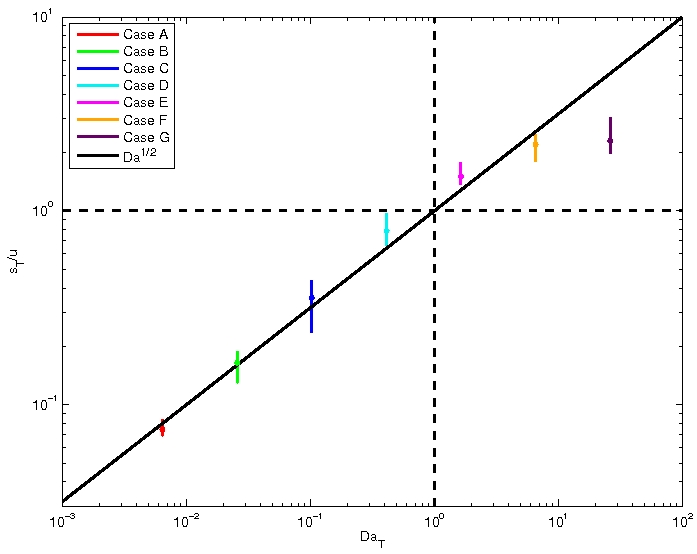
Home |
Research |
Publications |
People |
BoxLib |
Links |
Downloads |
Distributed Flames in Type Ia Supernovae
Introduction
In a previous paper (referred to here as paper I, see also here) we used three-dimensional simulations to examine the interaction of turbulence with a thermonuclear carbon-burning flame at a variety of Karlovitz numbers. It was shown that at a Karlovitz number of approximately 230, the flame presented a completely different mode of burning where turbulent mixing dominated species and thermal diffusion - a distributed flame was observed.
Theory
Damkohler (1940), by analogy with laminar flames, predicted that the turbulent flame speed and width in this so-called small-scale turbulence regime should follow the relations

|
and |

|
for DT and τnuc are the turbulent diffusion coefficient and nuclear burning time scale respectively.
In this study, we start with the high Karlovitz number case from paper I, and investigate the predictions made by Damkohler by moving to larger and larger domains keeping the Karlovitz number fixed, effectively increasing the Damkohler number. Both sT and lT are predicted to scale with Da1/2.
Simulations

|
Following paper I, three-dimensional simulations were run arranged with fuel below ash as shown in the figure on the left. Periodic lateral boundary conditions were used, with a solid base and outflow at the top, resulting in a downward propagating flame. A high aspect ratio domain was used to allow the flame sufficient room to propagate. A background turbulent field was maintained using a time-dependent zero-mean forcing term consisting of a superposition of low wavenumber Fourier modes. A range of Damkohler numbers was simulated by changing the domain size, keeping the Karlovitz number fixed. This ensures the energy dissipation rate in each case is the same - the turbulent energy cascade is consistent with the same star. |
The fuel density in each case was 107 g/cm3. A total of five cases were simulated, the details of which are summarized in the table below:
| Case | (a) | (b) | (c) | (d) | (e) | (f) | (g) |
| Domain width (cm) | 1.5x102 | 1.2x103 | 9.6x103 | 7.68x104 | 6.14x105 | 4.92x106 | 3.93x107 |
| Domain height (cm) | 1.2x103 | 4.8x103 | 3.84x104 | 3.07x105 | 2.46x106 | 1.97x107 | 1.57x108 |
| Integral length scale (cm) | 1.5x101 | 1.2x102 | 9.6x102 | 7.68x103 | 6.14x104 | 4.92x105 | 3.93x106 |
| Turbulent intensity (x105cm/s) | 2.47 | 4.93 | 9.86 | 19.7 | 39.5 | 78.9 | 158 |
| Damkohler number | 0.0064 | 0.026 | 0.1 | 4.1 | 1.7 | 6.6 | 26 |

Slices of density (top) and burning rate (bottom) are shown for all seven cases above, (a)-(g) left-to-right. In each case the domain size increases by a factor of 8 in each direction. As the turbulent width is predicted to grow with Da1/2, the flame gets relatively thiner compared to the domain width. The burning rate appears to decrease but due to the greater volume of fluid burning, the global burning rate greatly increases.
Any questions should be directed to Andy Aspden.
References
 A. J. Aspden,
J. B. Bell, S. E. Woosley,
"Distributed Flames in Type Ia Supernovae",
Astrophysical Journal, 710, 1654-1663, February 2010.
[ApJ]
[pdf]
A. J. Aspden,
J. B. Bell, S. E. Woosley,
"Distributed Flames in Type Ia Supernovae",
Astrophysical Journal, 710, 1654-1663, February 2010.
[ApJ]
[pdf]
 S. E. Woosley, A. R. Kerstein, V. Sankaran, A. J. Aspden and F. Ropke
"Type Ia Supernovae: Calculations of Turbulent Flames Using the
Linear Eddy Model",
Astrophysical Journal, 704,
pp.255-273, October 10, 2009.
[ApJ]
S. E. Woosley, A. R. Kerstein, V. Sankaran, A. J. Aspden and F. Ropke
"Type Ia Supernovae: Calculations of Turbulent Flames Using the
Linear Eddy Model",
Astrophysical Journal, 704,
pp.255-273, October 10, 2009.
[ApJ]
A. J. Aspden, J. B. Bell, M. S. Day, S. E. Woosley, M. Zingale, "Turbulence-Flame Interactions in Type Ia Supernovae", Astrophysical Journal, 689, pp.1173-1185, December 20, 2008. [ApJ] [pdf] [pdf2]
A. J. Aspden, J. B. Bell, and S. E. Woosley "Distributed Flames in Type Ia Supernovae" accepted for publication in the Astrophysical Journal.
G. Damkohler, "Der Einfluss der Turbulenz auf die Flammengeschwindigenkeit in Gasgemishcen", Z. Elektrochem, 46, 1940.
